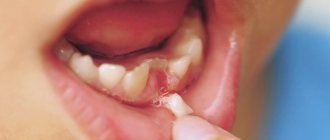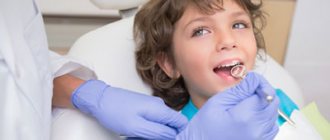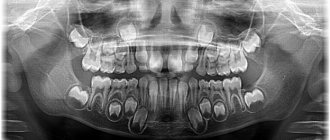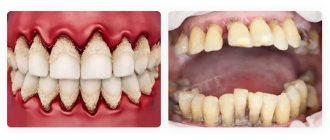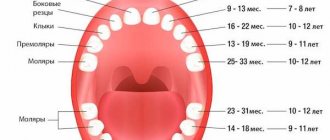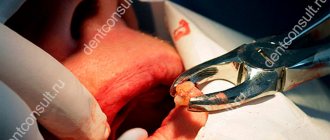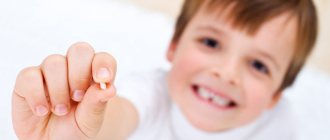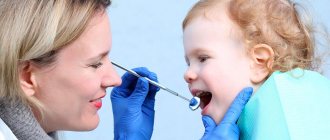In children from the age of 5, temporary milk teeth begin to fall out and are gradually replaced by permanent ones, which will serve for the rest of their lives. Many parents are interested in the question: how many teeth change in childhood? All baby teeth fall in, and permanent teeth grow in their place. They change in the same order as during teething. But parents should know that at the age of 6-7, the baby begins to grow his first permanent molars (sixth teeth) - they are the ones that remain for life. Children's fifth molars are the last to fall out and are replaced with permanent molars. Teeth are completely replaced by about 12-14 years, but it all depends on the individual characteristics of the body and various other factors.
Often, during tooth replacement, some non-standard situations and features can be observed, because of which parents begin to worry. Let's take a brief look at the most common questions:
Anatomy of permanent teeth
The molar tooth includes three zones: the root, which sits deep in the jaw socket and holds the tooth in place, the neck, located in the periodontal area, and the crown, which extends directly into the oral cavity. After the apex of the tooth appears, a protective film forms on the enamel, the strongest layer of the tooth, which is soon replaced by a salivary layer, formed from the saliva itself. The dental tissues themselves are not just a piece of bone, but a certain heterogeneity, which includes, in addition to enamel, dentin (the main substance of the tooth) and the dental cavity, in which nerves and blood vessels branch. Compared to bones, for example, the phalanges of the fingers, dentin is noticeably stronger - it contains an increased amount of minerals, for example, the same calcium-based compounds. The root zone of dentin is connected to the periodontium using a special layer - dental cement, which communicates with the tissues of the periodontium itself and supplies the dentin with nutrients.
Differences between baby teeth and permanent teeth
The structure of primary and permanent teeth is generally the same, but there are several noticeable differences. Which are better not to neglect:
Baby teeth have whiter enamel, while permanent teeth have a slight yellowish tint. Milk teeth are not as strong as permanent teeth due to the lower percentage of mineral substances. The pulp of baby teeth is wider and thicker, while dentin and enamel are, on the contrary, thinner. This explains the facilitated, spontaneous removal of a shelf tooth - there are often situations when schoolchildren in class independently loosen and remove milk teeth that have served their purpose. In permanent teeth, the length is significantly greater, dominating over their width and cross-sectional area. The root of a baby tooth is thinner and shorter - a person is able to pull out a baby tooth without the help of specialists. Meanwhile, the permanent “embryo” of a real tooth under the shelf one is already ready to grow quickly and be born. The latter is achieved due to the dental gap, which has expanded by the time the non-permanent tooth falls out.
What reactions of a child’s body are possible during the period of loss of baby teeth and growth of permanent teeth?
Replacing teeth is almost painless. The loss of baby teeth occurs on their own after their root is completely absorbed or removed at home, and if the permanent tooth is already growing, but the permanent one has not yet fallen out, the help of a pediatric dentist is required. When permanent teeth erupt, pain usually does not occur. Very rarely, there may be a slight increase in body temperature, itching of the gums or discomfort in the abdomen. In this case, the child does not need treatment, but it is recommended to visit a dentist.
Where do teeth come from?
Teeth are formed in the fetus’s body during the mother’s pregnancy. When a mother abused something and undermined her own health, the subsequently born child was guaranteed to have diseased teeth that were no longer permanent. At the 15th week of pregnancy, the mother has hardened dental tissues in the fetus - starting from the crown area and ending with the root zone. The embryos of molar teeth are formed by the 5th month of fetal life. The body of a developing fetus and child is designed in such a way that in the upper jaw the anlage of the permanent teeth is located above the anlage of the milk teeth, and in the lower jaw - vice versa. The formation and development of teeth begins as early as the sixth week of fetal development. The source for them is a special epithelial dental plate. Already by 14 weeks of pregnancy, the unborn baby is actively forming hard dental tissues, initially in the area of the coronal part, and then in the area of the roots of the tooth. When a child is born, primary teeth are the first to grow - by the end of the child's first year of life, they will erupt. However, the dentition contains a group of large molars - they, in turn, do not have milk predecessors and subsequently, when they fall out, grow “on a permanent basis”. Nature has arranged it in such a way that while the child’s jaws are still too small, large molars are not needed there.
Why does a person's teeth change?
The structure and development of the dentition in different animals differs significantly from each other. In vertebrates and some species of reptiles, for example, teeth change several times in their lives, and over time, a new one grows in place of the lost tooth; in rodents, permanent teeth immediately grow. This is due to the characteristics of the body, residence and nutrition of representatives of the animal world.
There are several species of mammals whose teeth change once in their lifetime during childhood. This is necessary not only for the growth of the body, but also for survival - after the baby stops feeding on mother’s milk, its life largely depends on the capabilities of the dental apparatus. Humans can also be classified as mammals in this category, so changing teeth is an integral process of growing up for them.
How many primary and molar teeth does a person have?
In children, the size of the jaw is almost half (in terms of the number of teeth that fit on it) smaller than in adults. Initially, the child has up to 20 teeth - 10 on each jaw. That is, one jaw - 4 incisors, 2 canines and 4 molars. Primary molars have not yet been clearly divided into small and large.
After 16 years, a teenager’s jaws reach approximate sizes that are accessible to an adult. A teenager already has approximately 28-30 teeth, and not 20-24, as before. The number of molars is often represented by 2 small molars and 2 large molars - on each side on each jaw. The last 2 or 4 teeth - “wisdom teeth” usually appear by the age of 20-22 - and a person acquires a full set of teeth, numbering 8 incisors, 4 canines, 8 small molars and 12 large molars - on both jaws in total.
History of the study of the issue
In light of the current sad realities, every literate person knows the main symptoms of coronavirus infection: breathing problems, weakness, loss of smell, cough and fever. In some cases, some of them persist even after recovery, creating a picture of post-viral syndrome, or, as doctors say, an “infectious train.” As it now turns out, that’s not all: hair sometimes falls out after coronavirus.
In the summer of 2021, Japanese scientists conducted a number of studies confirming the connection between COVID-19 and diffuse alopecia. According to the data obtained, almost a quarter of those surveyed experience hair loss after Covid.
Moreover, this unpleasant surprise awaits those who have recovered from COVID-19 when they have practically forgotten about the disease, that is, 2-3 months after recovery.
A natural question arises: what to do if your hair falls out after coronavirus? The most correct answer is: don't panic. Don't run to the pharmacy for “magic pills” and horse shampoo. It is necessary to contact a highly qualified trichologist.
What does the dental formula look like?
The medical record, which the big one keeps in the dental clinic at his place of residence, contains notes about his dental condition. To avoid confusion, doctors number the teeth on each side of each jaw. So, the 1st and 2nd teeth are incisors, the 3rd are canines, the 4th and 5th are small molars (doctors call molars molars), the 6th and 7th are large molars. The 8th - the farthest one - is a “wisdom tooth”; a number of people do not have it, or they do, but not all. Each side of the jaw is also numbered: 1 - top right, 2 - top left, 3 - bottom left, 4 - bottom right. For example, entry 48 does not mean that you are a “Tarkatan” with a combat superset of teeth that does not exist. You simply do not have a “wisdom tooth” on the lower right. Entry 41 - a person lost one of the frontal incisors on the same side on the same jaw. You can write down the formula of the teeth more clearly: for example, “there is no 8th tooth from the bottom right.”
It often turns out that due to lack of space on the jaw, the wisdom tooth develops incorrectly - it can grow crooked, in which case its removal is indicated. For example, it may remain under the gum and, because of this, be affected by caries, which can subsequently develop into pulpitis or a dental cyst. Problematic “wisdom teeth” are quickly and decisively removed, and their absence will not greatly affect the quality of chewing food.
Photos of our cosmetology
Other services
- Cosmetology
- Dermatology
- Removal of moles and neoplasms
- Ear piercing
- Lip augmentation
- Botox
- Hair treatment
- Dentistry
- Massage
Teething order
The timing of the appearance of permanent teeth to replace lost milk teeth is generally the same for all children and adolescents. After the child turns 5 years old, the first large molars make themselves felt. Then the central incisors are replaced from below, then the same teeth from above, and the lateral incisors from below. At 8-9 years of age, the lateral incisors on top are replaced. From 9 to 12 years of age, all small molars are replaced. At 13, all fangs are replaced. After 14 years, second large molars appear on all sides, which were not there before. By the age of 20-22, “wisdom teeth” finally appear. There are cases when during the rest of their lives they never erupted.
What to do if a tooth does not grow after a baby tooth falls out?
Ideally, teeth change as follows. The molar located in the gum begins to move upward. This serves as a signal to the dairy that it is time to make room. Its roots begin to dissolve, and it itself becomes mobile. The baby may feel that the tooth has become loose, but it will not fall out quickly. It takes time for the roots to be reabsorbed; this takes several months. As the molar or molar grows, the roots of the predecessor become smaller and smaller. At some point, it falls out, and in the hole that remains in its place, the cap of the original “replacement” is already visible.
But it also happens that a molar tooth does not replace a lost baby tooth. And this is a reason to consult an orthodontist.
“Such problems can arise if there is not enough space in the child’s bite for the eruption of permanent teeth,” comments pediatric dentist Victoria Arutyunova. - Molars are larger in size than baby teeth. And if the freed up space is not enough for a permanent tooth to erupt, it may remain in the gum.”
The orthodontist will give you a referral for a panoramic photograph of the jaw. This is a completely painless procedure that will allow you to see the location of all molars in the gums. Based on the image taken, the doctor will offer options for solving the problem. Modern orthodontic techniques help eliminate malocclusion in children of all ages.
pixabay.com/
How to determine that a child will soon have molars?
According to some of the signs, interdental intervals initially increase. This happens due to the growth of the jaw bones - the teeth begin to not fit tightly together, as happens in adults. Then the temporary teeth gradually become loose - due to the gradual disappearance of the temporary root, which can no longer reliably hold such a tooth, and itself is gradually pushed out of the soft and semi-soft tissues on the jaw. The loss of a temporary tooth is a clear sign that the permanent tooth is already growing in full force, and the top of its crown will soon push apart the gum tissue. The appearance of a new tooth is also accompanied by slight redness and swelling. If a child or teenager has a fever, their health has worsened, and their gums hurt, go to the doctor immediately.
How and when do teeth change?
Loss of primary teeth begins at approximately 6-7 years of age and usually lasts until 10-12 years of age. Note that girls say goodbye to temporary teeth earlier than boys and the replacement process itself is more dynamic for them.
Parents will be able to guess that their child’s baby teeth are about to change due to a number of factors: due to jaw growth, the distance between the incisors will increase, the rudiments of molars become visible under the baby teeth, and the primary teeth become loose.
On average, the age at which a child changes teeth corresponds to the years given in the tables below:
Order of loss of baby teeth
| Age | What teeth fall out |
| 6-7 years | Central incisors fall out |
| 7-8 years | Lateral incisors fall out |
| 9-11 years | The child loses his first molars |
| 10-12 | Canines and second molars fall out |
⠀
Please note that the new tooth may not be in a hurry to take the place of the fallen one. If a couple of weeks or even more than a month have passed and there is still no molar, this is not a reason to panic. Also keep in mind that there are more molars, so some take their place without changing their predecessors. For example, molars or (the first permanent molars), erupt from scratch at the age of 5-7 years - they should not be confused with milk teeth.
Growth of molars
Image source
Molars are called a little differently than baby teeth. Try not to get confused:
| Molar | Age of appearance | Which milk tooth replaces |
| Central incisors | 6-8 years | Central incisors |
| Lateral incisors | 7-9 years | Lateral incisors |
| Fangs | 10-13 years | Fangs |
| First premolars | 9-12 years | First molar |
| Second premolars | 10-13 years | Second molar |
| First molars | 5-7 years | Do not replace baby teeth |
| Second molars | 11-14 years old | Do not replace baby teeth |
| Third molars | 17-25 years old | Do not replace baby teeth |
⠀
If you do not take into account the third molars (which are also called wisdom teeth), girls receive a fully formed jaw by 11-13 years, and boys by 13-14 years.
It is important to understand that the baby tooth may not be replaced. For example, if the germ of a molar tooth has died, then nothing pushes the temporary tooth to leave the mouth. People live with partial milk teeth even into their 30s. Therefore, if a baby tooth does not fall out, you should not try to loosen it or try to pull it out at home. Below we will look at other problems when changing teeth.
No molars
The molars, despite the specific timing specified above, may ultimately not hatch. For example, temporary teeth do not fall out for a long time, and permanent teeth do not grow for a long time after they fall out. At the first stage, the dentist will take an X-ray of the condition of the child or teenager’s jaws. The X-ray machine will clearly project what should grow in place of the supposed teeth, which teeth are ready to hatch, and whether they exist at all. But the problem will immediately become obvious, and the reason for it most likely lies in the physiology of the child, which has undergone some delay. If this is true, be patient: in the end, the teeth will not take long to arrive. But if the picture shows emptiness, you are faced with a complete absence of teeth, the reason for which is a violation of the intrauterine development of the fetus during the mother’s pregnancy. Only prosthetics will help here - artificial insertion of false teeth.
The nature of alopecia after COVID-19
Previous COVID-19 can cause so-called “diffuse” alopecia. It manifests itself in uniform hair loss over the entire area: no obvious “bald patches” are formed, but the hair is noticeably thinning, and its structure may additionally be disrupted. Sometimes the hair simply “falls out” from the head; in milder cases, it falls out with a slightly greater intensity than usual.
The reason for this phenomenon is a failure of the natural hair development cycle, caused simultaneously by several factors. The first and most significant is a disruption of normal blood supply caused by serious damage to the vascular wall, and as a consequence, the entire vascular bed. Recently, doctors and scientists are finding more and more facts confirming this. The situation is further aggravated by stress, intoxication, hormonal imbalance, and taking strong medications in large doses, which is necessary for severe cases of Covid.
This disease, especially in moderate and severe forms, certainly affects all systems of the body to one degree or another. Under unfavorable conditions, the natural order of alternating phases of rest and activity of hair follicles is disrupted, which also aggravates the situation: hair falls out rapidly, and new ones do not grow, since the activity of the follicles is reduced or absent.
Are there any chances? Yes: the follicles do not die when they fall asleep, so it is quite possible to restore the thickness of the hairline. But this requires properly prescribed treatment.
After coronavirus, both men and women experience hair loss: diffuse alopecia is indifferent to a person’s gender. This differs from androgenetic alopecia, which affects mainly representatives of the stronger half of humanity. The connection between the severity of the disease and the intensity of hair loss has not yet been established.
Molar tooth hurts
After the molar has emerged from the gums, the “young” tooth enamel is not fully saturated with all the necessary microelements. During this period, the tooth is especially vulnerable: it is strictly forbidden to subject it to overload. It is not for nothing that children are advised not to chew, for example, candy, large quantities of peanuts, or any solid foods. If you neglect this rule, children may immediately develop caries, and this is the path to problems with specific teeth. Caries gradually turns into pulpitis (damage to the internal cavity of the tooth) and periodontitis (damage to the ligaments surrounding the tooth). The child often experiences toothache and poor general health. Without turning to a professional doctor for help in time, parents can lead their child to various consequences - up to the complete loss of a diseased tooth. If a predisposition to the appearance of carious lesions has been identified, their prevention may involve closing the natural deep pockets surrounding the molars. This is done using high-quality composite materials. In this case, food debris will not accumulate in these places, destructive microflora will not develop, and the period of susceptibility to caries will pass when the teenager grows up.
What can cause severe hair loss?
When it comes to serious hair loss, up to the need for medical intervention, it is most often associated with diseases and conditions that are genetically determined: anamnesis allows us to find out a roughly similar picture to the condition of the hair in the patient’s closest relatives. You can’t go against heredity, but there are a number of provoking factors that negatively affect curls, and at the same time can be successfully corrected.
- Hormonal imbalance due to diseases (primarily of the endocrine or reproductive systems) or taking hormone-containing drugs. They can stimulate hair loss and hormonal changes associated with pregnancy, childbirth, lactation, menopause in women, adolescence or retirement.
- Stress, nervous tension: the condition of the hair is very closely related to the health of our nervous system. The reaction to hair stress most often manifests itself 3-4 months after a traumatic situation: the hormone cortisol, which is released abundantly during shocks, leads to changes in the functioning of many body systems and disruption of the nutrition of the hair follicles. The growth of new hair stops, the already growing strands become thinner and begin to fall out. By the way, stress is not only emotional, but also physical: surgery, high fever, injury, etc.
- Hair coloring. Aggressive exposure to chemicals can cause damage to the scalp, and therefore the hair follicles, causing hair loss. The more intense the exposure to dyes and oxidizing agents, the deeper the damage (this is why the strands suffer so seriously when lightening or radically changing color). Sometimes, after dyeing in dark colors, the curls do not begin to fall out more, although this is exactly the impression that arises: simply fallen dark hairs are more noticeable than light hairs.
- Lack of nutrition. Strict diets, cutting back on proteins, fats or carbohydrates, lack of vegetables and fruits - all this leads to the fact that the body simply does not have enough nutrients to form healthy hair. The period of active hair growth is reduced, it goes into a resting stage and falls out. Sometimes the lack of nutrients is caused not by their insufficient intake from food, but by absorption problems (diseases of the digestive or circulatory systems, metabolism).
- Abuse of sweets. Excess sugar entering the body causes insulin spikes, which significantly weakens the cells of the hair follicles. In addition, sugar removes minerals (in particular calcium) and vitamins from the body, depletes the supply of proteins, and provokes coarsening and destruction of collagen (a protein that is an important component of hair).
- Taking certain medications and dietary supplements: antidepressants, painkillers, antibiotics, drugs for the treatment of arterial hypertension, anticoagulants, and many others. Other medications cause the hair follicle to transition from the anagen (active growth) stage to the telogen (death) stage. In addition, the cells of the hair follicle are very susceptible to toxic substances and are poisoned by the breakdown products of drugs.
- Hairstyles due to which the curls are in a state of prolonged tension: tight braids, ponytails, plaits, backcombing, etc. Blood circulation in the scalp is disrupted, as a result of which the hair follicles stop working, sometimes forever.
- Exposure to the external environment, in particular ultraviolet radiation. Curls really don’t like sudden changes in temperature, especially overheating. When we are in the sun with our heads uncovered, the skin burns and a superficial burn is formed, which negatively affects the functioning of the follicles. Also, due to ultraviolet radiation, the functions of the thyroid gland can be disrupted, which affects the curls.
Important! Doctors call intense pathological hair loss alopecia (baldness). Various unfavorable factors can become the trigger that makes a genetic predisposition to baldness work.
Molars grow crooked
Molars are also subject to crooked growth. They can begin to actively grow before the temporary ones become loose and fall out. Encountering this natural obstacle in the process of their growth, they can grow crookedly than would be intended by nature - they are “led” to the side. If the growth of a molar is detected immediately after a temporary one, this defect leads to a curvature of the bite, which is why the child or teenager will need the help of an orthodontist. In this case, it is necessary to urgently remove the temporary tooth that is interfering with the growth of the permanent one. If time has not yet been lost, it may be possible in this way to remove the predisposition of the same tooth to acquired curvature. Despite the fact that a teenager, having realized the uselessness of a temporary tooth, can independently loosen it and remove it, doctors strongly advise refraining from such a step so that the child avoids, for example, sepsis.
Hair loss after coronavirus: advice from a trichologist
So, what to do if your hair falls out a lot after coronavirus.
- Don't panic and realistically assess the situation. Each person has their own daily rate of hair loss - for some it is 10, for others it is 50. Problems are indicated by an increase in this amount relative to your own indicator before the disease. Only then should you sound the alarm.
- Do not subject your hair to additional tests. At this time, you should not dye, laminate, extend your hair, straighten or curl it - in a word, actively influence the hair. It is enough to wash and comb your hair as usual. Recommendations on the choice of shampoo, conditioners and hair masks will be given by a trichologist on an individual basis.
- Eat properly. Hair loss after Covid is not the best time to try veganism or therapeutic fasting. The diet must contain foods high in protein and sufficient fat, because they are the main “building materials” in the body.
- Follow doctor's orders. Vitamin-mineral complexes containing iron, myctoelements and vitamin D are often prescribed - these are what the body most often lacks. Special diet: a large number of foods containing vitamins A, E, C.
- Use additional hair treatment methods: mesotherapy, cryotherapy, darsonval. A course of complex treatment is the best way to restore beautiful and healthy hair.
If the hair is not treated, then, perhaps, over time, the body will recover and lush hair will once again delight its owner. This will take at least a year, since on average new hair grows by 1-2 centimeters per month, and this is after the hair follicles awaken. In most cases, hair requires the help of a qualified specialist.
Molars fall out
If molars suddenly begin to fall out suddenly, this is a sign that the child’s health is not in the best condition. Tooth loss is preceded by both systemic diseases (immune problems, impaired development of connective tissue) and local ones (caries, pulpitis, periodontal disease, etc.). Tooth from permanent dentition. When lost, it leaves behind a permanent problem. A radical solution could be a complete insertion of an artificial tooth - but... Before it is carried out, the child will have to use a removable and replaceable prosthesis before he grows up.
Why does hair fall out a lot after coronavirus?
The immediate causes of hair loss after Covid have not yet been well studied: this disease struck humanity relatively recently. But it is already known that SARS-CoV-2 has a negative effect on all organs and systems of the body, including the scalp.
Among the most obvious causes of the so-called “Covid alopecia” are:
- disruption of blood supply and microcirculation due to vascular damage;
- hypoxia and impaired gas exchange in tissues (including in the epidermis of the head where the hair follicles are located);
- intoxication caused directly by SARS-CoV-2;
- changes in the composition of the blood causing iron deficiency;
- stress caused by illness;
- changes in hormonal levels;
- consequences of drug therapy.
All these factors must be considered as a whole: our body is a complex system where everything is interconnected. It is impossible to single out one reason why hair falls out after Covid, and what exactly to do in this situation can only be said after undergoing an examination.
Injuries
An accident or incident, such as a fight, can cause a tooth injury. And it doesn’t matter whether a small part has broken off, or the tooth has cracked, as they say, “to the point of bleeding” - the help of a doctor is definitely needed. In some cases, lost dental tissue is replenished. If a tooth is broken into pieces, it will most likely need to be completely removed and a prosthesis replaced every year. And the answer is simple - the dental tissues have not yet fully matured, the body is growing. And it is necessary to take full care of your teeth at such an early age. In case of extension, the operation is performed by introducing composite materials that replace enamel and dentin.
Trichology in Krasnogorsk: honey invites!
If you notice that your hair has begun to fall out more intensely than usual, there is no need to try to deal with the problem yourself: perhaps its roots lie deeper than it seems at first glance.
Our trichologist with specialized education and over 20 years of experience will examine and diagnose the disease, prescribe adequate treatment and give recommendations to promote rapid hair restoration. The sooner you seek help, the sooner you will see that your hair has regained its healthy thickness and shine!

